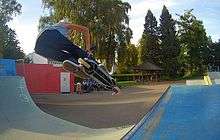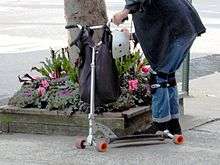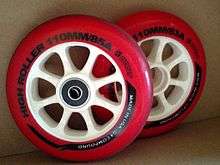Kick scooter
A kick scooter, push scooter or scooter is a human-powered land vehicle with a handlebar, deck and wheels that is propelled by a rider pushing off the ground. The most common scooters today are made of aluminum, titanium and steel. Some kick scooters that are made for younger children have 3 or 4 wheels and are made of plastic or do not fold. High-performance racing scooters made for adults resemble the old "penny-farthing".[1]
Models and history
Early scooters

Primitive scooters have been handmade in industrial urban areas for at least 100 years. One common homemade version is made by attaching roller skate wheel sets to a board with some kind of handle, usually an old box.[2] You can lean to turn, or by a second board connected by a crude pivot. The construction was all wood, with 3–4 inch (75–100 mm) wheels with steel ball bearings. An additional advantage of this construction was loud noise, just like from a "real" vehicle. An alternative construction consists of one steel clamp–on roller skate divided into front and rear parts and attached to a wood beam.
Honda Kick 'n Go
In 1974 the Honda company made the Kick 'n Go.[3] While it seemed to be as much effort to "kick" as a regular scooter, the novelty of it caught on and it became popular nevertheless.
Pneumatic tires
Before bicycles became popular among children, steel scooters with two small bicycle wheels had been the most useful vehicles for them. Around 1987, many BMX manufacturers produced BMX-like scooters as Scoot.[4] Those manufacturers discontinued their scooters, but some scooter manufacturers were established after years, and still develop similar scooters today; Some are used in dense urban areas for utility purposes, being faster than a folding scooter and more convenient than a utility bicycle. Some are made for off-road use and are described as Mountain Scooters. Besides commuting, sports competition and off-road use, large wheel scooters are a favorite for Dog scootering where single or team dogs such as huskies pull a scooter and rider in the same way that a sled is pulled across snow. Some Amish are not allowed to ride bicycles, so they ride scooters instead.[5] Today variations on the kicksled with scooter design features are also available, such as the Kickspark.
Kickbike


The development of the kickbike[6] in Finland in 1994 changed the way scooters are viewed. The kickbike has a large standard size bicycle front wheel and a much smaller rear wheel, allowing a much faster ride. The Footbike Eurocup has been held since 2001.[7]
Folding scooters

In 1996, a foldable aluminium scooter with inline skates wheels was created by Wim Ouboter of Micro Mobility Systems in Switzerland[8][9] The scooter was sold as "Micro Skate Scooter", "Razor" and "JDBUG/JDRAZOR MS-130A".[10] After the Razor was introduced to Japan in 1999, many young people in Tokyo began to use it as a portable transporter then it became a fad around the world, and such small scooters also became popular toys for children.[11]
Stunt scooter

A more recent development, these scooters are produced to be as lightweight and strong as possible, allowing riders to perform tricks at skateparks and on the street. Often featuring a fully welded aluminium construction, these scooters allow for more extreme tricks than a traditional variation. by many manufacturers.
Large folding scooters
Folding kick scooters optimized for adults generally have more durable parts and are designed with wider decks, hand brake, and larger wheels,[12] for smoother transportation instead of less weight and portability. An example is the Xootr Street, which incorporates 180 mm (7.1 in) wheels with a maximum load of 300 lbs (136 kg).[13] Another example is the Go-Ped Know-Ped, which incorporates 6 in wheels with solid-rubber tires with a maximum load of 400 lbs (181 kg).[14] and its variant KickPed from NYCeWheels which is stripped of all sensitive parts, such as a handbrake which is replaced with a rear spoon brake in order to make the kick scooter long-lasting and durable[15]
 Early Razor scooter with 98mm wheels
Early Razor scooter with 98mm wheels Folded Razor scooter
Folded Razor scooter A Mini Micro scooter with three wheels
A Mini Micro scooter with three wheels- Xootr scooters in the USA
Three wheels

Three-wheeled scooters like tricycles have been produced for little children.
In 1999, Micro Mobility Systems and K2 Sports produced a reverse-three-wheeled scooter as "Kickboard". Micro also produced the Kickboard-like children's scooters as "Mini Micro" and "Maxi Micro". The reverse design inherently provides greater stability than the standard: a standing person will tend to stand at the front of a scooter rather than at the back. However, the steering geometry is inherently weak and requires design adaptation to improve its response. An example is the Mini Micro, which uses a spring-loaded system to translate lateral force on the handbars (child leaning) into turning motion on the wheels, referred by its makers as "lean and steer".
Four wheels

The early scooters, which were made with roller skates, were four-wheeled like skateboards.
Around 2000, A Swiss company produced a four-wheeled scooter as "Wetzer Stickboard". The Stickboard was a narrow skateboard with a foldable pole on the nose.[16]
In 2006, a company called Nextsport started producing a line of four-wheeled scooters, known as Fuzions. Fuzion scooters are typically bigger and heavier than Razor and Micro models. The early Fuzion models come with large, wide wheels, and an oversized deck for carving stability. Later scooters, such as the Fuzion NX, include smaller, harder wheels, and 360 degree handlebar spinning capabilities, unlike its predecessors. The aforementioned are all classified under Fuzion Scooter's new Pro Scooters line up which includes models like the Z300, Z400 and X-3.
There are also a few instances of freestyle scooter riders mounting skateboard trucks to standard aluminum style scooters to make four-wheelers.
Comparison with the bicycle

Unlike a kick scooter, a bicycle has a seat and drive train, which add speed, cost, weight and bulk. A folding scooter can be more easily carried than a folding bicycle or even a portable bicycle. Even a non-folding scooter is easier to maneuver between obstacles, as there are no protruding pedals. Thus a cyclist has advantages in longer journeys and open spaces, and a kick scooter in shorter and more crowded ones. Kick scooters seldom have a luggage rack, so the rider usually carries any cargo on their back.
At low speeds a bicycle is difficult to control while pedaling, which is why cyclists occasionally kick their way through dense traffic or in other conditions where they cannot take advantage of the speed of their machine. Thanks to the superior low-speed stability of a kick scooter, it is allowed on many footpaths where riding a bicycle is forbidden.
Since the feet are nearer the ground on a scooter, it is easier to step on and off than even a step-through frame bicycle, hence the rider can alternate walking and pushing as energy and route dictate. Large wheel scooters afford a more effective cross training workout than standard bicycles as the whole body is engaged in the effort of kicking. Pushing or kicking a large wheel scooter places less stress on the knee joints than pedaling a bicycle, so it is often preferred by people with knee problems. Although the bicycle is a much more effective and efficient long distance machine, in 2001 Jim Delzer propelled a kick scooter across the United States.[17]
These factors aside, a bicycle is undoubtedly a vehicle more suited to rugged terrain or long roads, as the more compact scooter is less efficient when the aim is not easy maneuverability on a flat surface. This is shown in the use of bicycles outside of the city situation, except of course when trends influence either way, and fashion interferes with practicality.
Modifications

Most scooters have some compatibilities with bicycle or inline skates parts, so they can be upgraded easily.
Freestyle riders are modifying their scooters with the increase in the manufacturing of aftermarket kick scooter products. This includes items such as grips, one piece bars, one piece decks, complete deck griptape, aftermarket bearings and metalcore wheels. See Freestyle scootering#Freestyle Scooter Parts.
See also
- Chukudu - A freight vehicle in the Democratic Republic of the Congo
- Freestyle scootering
- Knee scooter - A walking aid for foot-injured person
- Motorized scooter - a motorized version of the kick scooter
- Electric kick scooter
References
- ↑ http://www.yourdictionary.com/kick-
- ↑ "Skateboarding - Skateboarding Games". crazyskateboardinggames.com.
- ↑ "Honda Kick-n-Go Scooter". Honda Kick-n-Go Scooter.
- ↑ GT Zoot Scoot, Mongoose Pro Miniscoot, SE Racing Rad Scoot, and more.
- ↑ "How do Amish travel?". amishamerica.com.
- ↑ Kickbike.
- ↑ Eurocup race results, IKSA world, 2001.
- ↑ "The Micro Scooter History". YouTube. 15 December 2011.
- ↑ "Inventor of the micro scooter". The Guardian. 2002-03-31..
- ↑ JDRAZOR MS-130A, JD Japan.
- ↑ "culture.bicycle.birdybike.general - Folding Scooter Story - msg#00015 - Recent Discussion OSDir.com". osdir.com.
- ↑ "Xootr bicycle for ultra minimalists". Using Bicycles..
- ↑ Kick-Scooter street, Xootr.
- ↑ Know-Ped, Go-Ped.
- ↑ http://www.nycewheels.com/kickped-kick-scooter.html
- ↑
- ↑ "Delzer first to cross US on a kickbike". suewidemark.com.
External links
![]() Media related to Kick scooters at Wikimedia Commons
Media related to Kick scooters at Wikimedia Commons